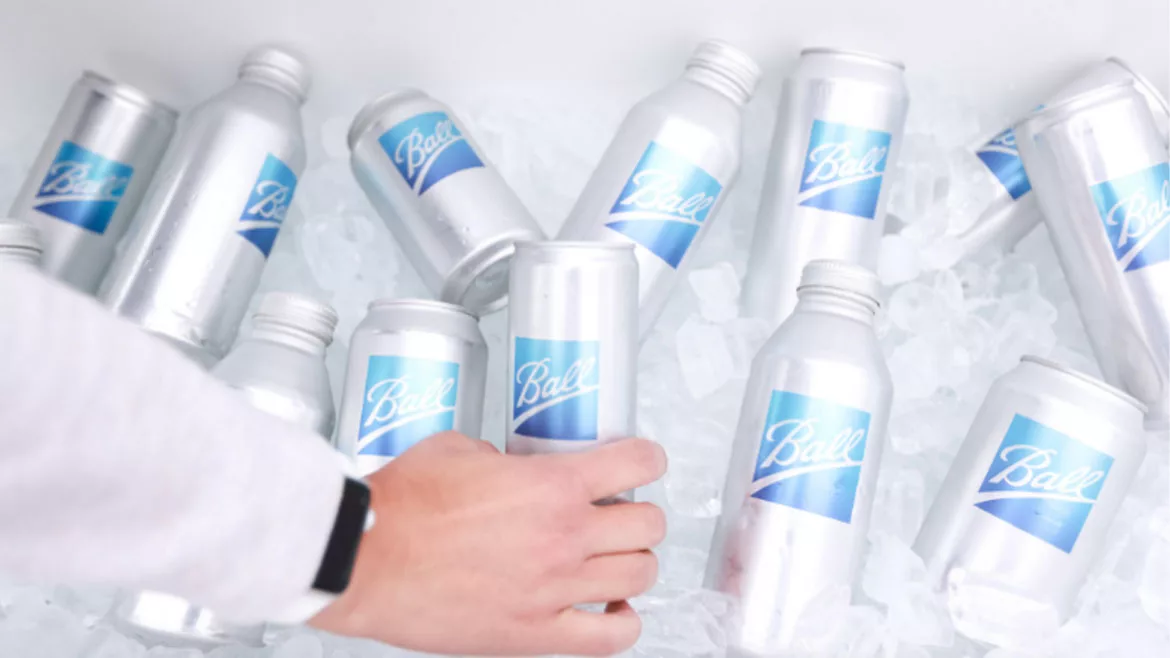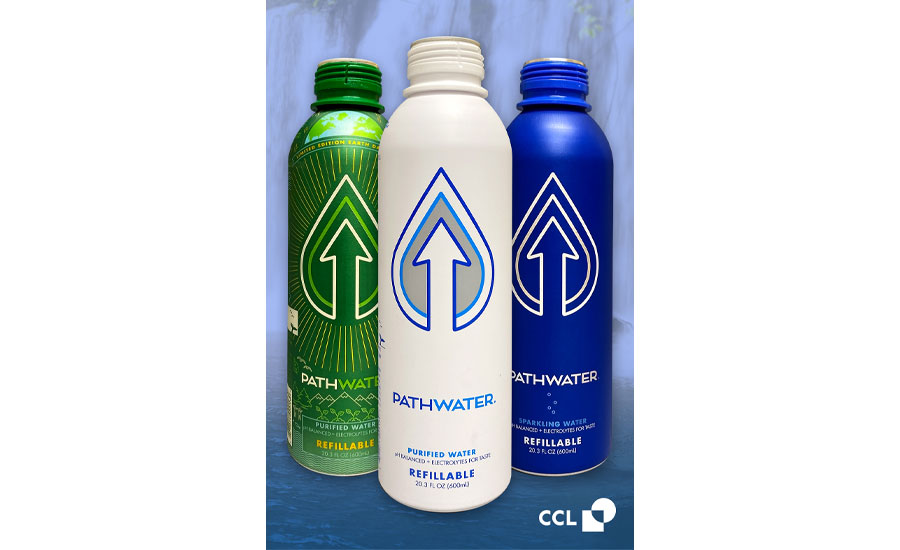Packaging Material
Numerous factors make aluminum attractive for beverage-makers
Packaging experts note recyclability, convenience as influences

Image courtesy of the Ball Corp.
In the 2008 musical film “High School Musical 3: Senior Year,” siblings Sharpay and Ryan Evans dream about their aspirations once leaving East High. In their duet “I Want It All,” they sing about their dream lives in New York City: their names on Broadway, performing at Radio City Music Hall and getting interviewed by Oprah Winfrey. The siblings simply want it all, and nothing less, as they express in the song.
While the Evans siblings demanded fame and fortune, the beverage industry has demanded more aluminum packaging.
Megan Sanford, director of marketing operations at Westminster, Colo.-based Ball Corp., says that this demand only increased in recent years, especially in categories such as ready-to-drink (RTD) cocktails and imported beer.
“At Ball, we believe this growth can be attributed to a number of factors that are converging with increased consumer demand for sustainability, including aluminum beverage packaging’s recycling strengths, its convenience and its potential for innovation — our products come in a wide variety of shapes and sizes,” Sanford explains.
Kim Kizer, vice president of sales at Hermitage, Pa.-based CCL Container, says that RTD cocktails continue to trend, which has caused an uptick in aluminum’s appeal. The company has an entire look book dedicated to its aluminum offerings.
“The growth of the post-pandemic, at-home cocktail culture, and increased preference for convenience, and the enhanced quality and diversity of premium RTD cocktails are factors behind the upsurge in demand,” Kizer says. “Premiumization of these product categories with respect to flavors, taste and quality, through aluminum package design, shaping and decorating is driving the trend to aluminum.”
Additionally, the demand for environmentally friendly containers has led to beverage companies choosing aluminum packaging over other options, experts note.
“Aluminum cans, bottles and cups are infinitely recyclable, experience high recycling rates and are truly circular — meaning they can be continuously remade into new products,” Ball’s Sanford says. “In fact, 75% of aluminum ever produced is still in use today, and an aluminum can, cup or bottle can be recycled and returned to a store shelf as a new product in about 60 days.”
Robert Budway, president of Washington, D.C.-based Can Manufacturers Institute (CMI), notes that aluminum beverage can manufacturers have seen “unprecedented demand” for eco-friendly containers by existing and new beverage companies.
“Recent trends indicate that more than 70% of new beverage product introductions are in aluminum cans and long-standing customers are moving away from plastic bottles and other packaging substrates to cans due to environmental concerts,” Budway says. “It is no surprise that beer, energy, health and soft drink beverage companies are enjoying the many benefits of the aluminum can, which has the highest recycling rate among all beverage packaging.”
Aluminum’s attributes
There are many reasons why beverage producers might opt for aluminum packaging, with benefits for companies and consumers.
Budway notes that sustainability, taste, convenience and performance are all reasons why beverage companies utilize aluminum packaging.
When it comes to sustainability, aluminum cans “lead the way in key measures of recycling rate, recycled content and value per ton,” he says. As for taste, Budway notes that aluminum cans ensure protection from oxygen and light.

Image courtesy of CCL Container
“Aluminum cans deliver on hitting all the consumer’s senses,” he explains. “From the moment a consumer sees the 360-degrees graphics to that particular sound a can makes when they crack open the top and they are about to experience the cold, refreshing taste that will put them in the drinker’s desired state.”
CCL’s Kizer offers similar sentiments regarding beverage protection, noting that aluminum packaging “offers unsurpassed barrier properties, keeping beverages fresh and safe.”
“It guarantees longer shelf life and contributes significantly to the sustainability of beverage products,” she says. “The lightness of aluminum packaging helps to save resources during filling, product transportation, storage and the transportation of scrap at the end of a product’s life.”
Additionally, aluminum is compatible to all printing technologies, granting designers “enormous opportunities” in terms of creating designs with strong shelf presence, Kizer notes.
Furthermore, metal cups offer many benefits, as they are sturdy, lightweight, durable and cool to the touch — an improved drinking experience for consumers, Kizer says.
Moreover, with consumers becoming more mindful of the impact everyday choices have on the environment, “consuming beverages in an infinitely recyclable cup is attracting the attention of more people,” she adds.
When it comes to wine bottles, Kizer notes that aluminum bottles have many benefits over its counterparts.
“Although acceptance has been slow, the distinct advantages, especially with respect to sustainability, are expected to make aluminum an increasingly attractive choice in the near future,” she says. “Compared to glass, aluminum bottles weigh less, making them cheaper to ship, and they’re also less likely to break. Greater thermal conductivity and chill retention enables aluminum bottles to cool quickly and stay cooler longer.”
Aside from recycling and taste perks, Ball Corp.’s Sanford notes that there are numerous options for aluminum alterations.
“In addition to its sustainability benefits, aluminum packaging has endless opportunities for innovation because it is made of just one material,” she explains.
In North America, Ball Corp. currently offers more than 15 can sizes, five aluminum cup sizes and several aluminum bottle shapes and sizes, which ensures that it can meet the variable needs of beverage brands, Sanford adds.
Sanford says that, while Ball Corp. does not make aluminum wine bottles, it produces wine cans.
“At Ball, we have a long history of partnering with brands to evolve and innovate our packaging to meet the needs of our customers and the broader marketplace, so it’s been exciting [to] see the category evolve and grow over the years,” she notes.
Popular demand
Long before the pandemic, consumers were demanding environmentally-friendly containers. CMI’s Budway says this trend has continued through today, forcing can manufacturers to fill these demands from all sectors of the industry.
“CMI members have committed to opening or have opened several new aluminum can manufacturing facilities in the United States. … The aluminum beverage can manufacturing industry has partnered with its dedicated supply chain to expand material sourcing to meet future demand,” he explains.
CCL’s Kizer also notes the increased demand of aluminum since the COVID-19 pandemic, mostly because consumers were enjoying their beverages at home.
“For many brands, it made sense to switch from glass bottles to aluminum,” she says. “With the shipping crisis brought on by the pandemic, companies changed from glass bottles to aluminum cans because [of] packaging ease and lower costs, as consumers started dining and drinking more at home.”
She adds that many brands are leaning toward aluminum for packaging, especially health drinks and RTD cocktails. Furthermore, big-name beverage brands are “addressing the plastic waste challenge by introducing new aluminum packaging” for their water brands, including PepsiCo and Nestle, she says.
Ball Corp.’s Sanford adds that aluminum cans were used by roughly 85% of all new beverages launched last year, compared with about 69% of beverages five years ago.
“These numbers reflect how companies see the sustainability and convenience benefits of aluminum and have been able to adapt the shape and size of aluminum products to best fit their needs,” she says.
Looking for a reprint of this article?
From high-res PDFs to custom plaques, order your copy today!







